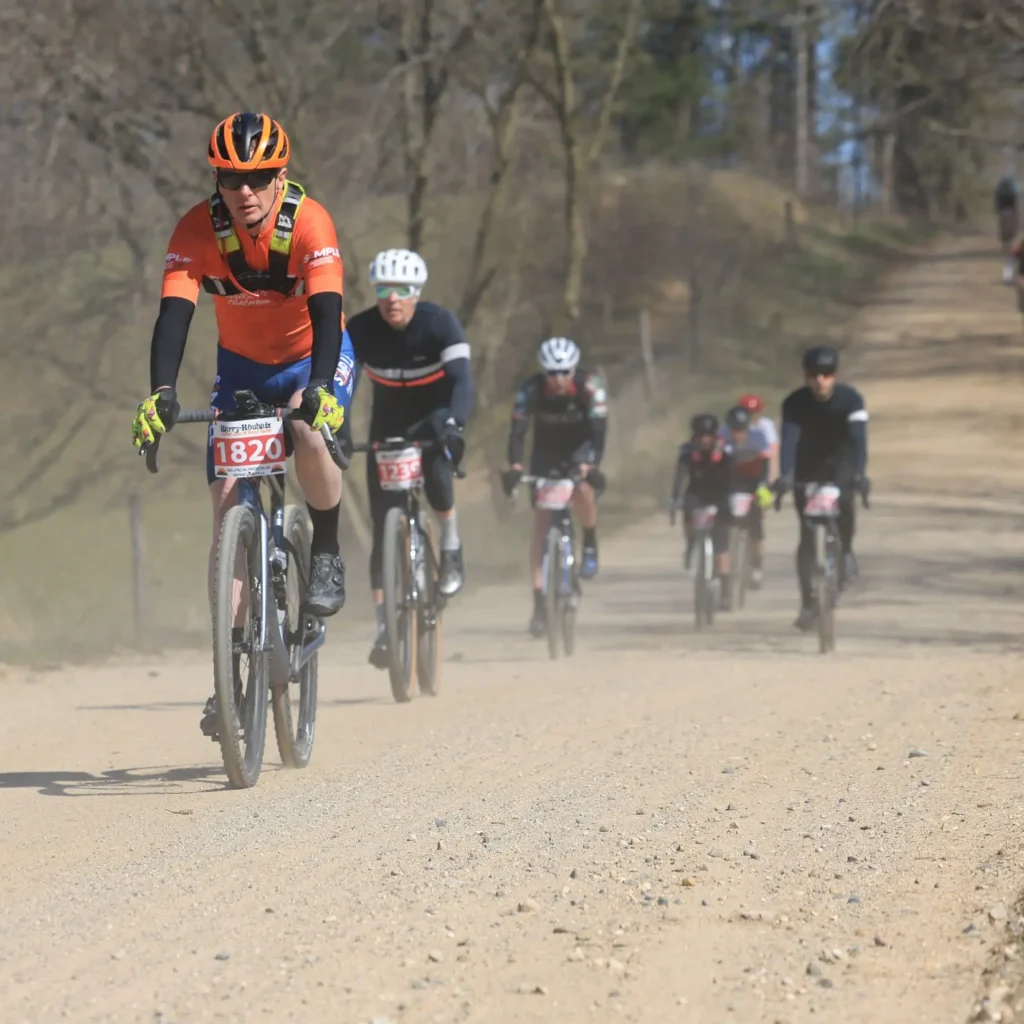Nasal breathing practice can improve health and fitness for everyday athletes
Take a deep breath.
Can you feel the rush of air entering your body, filling your lungs, invigorating every cell?
But did you breathe through your mouth or nose?
Breathing is something we often take for granted, but did you know that how you breathe can have a profound impact on your athletic performance?
As a lifelong asthmatic and now yoga instructor, I work on these techniques in myself and in clients: Learning how to breathe through our noses into our bellies.
Today’s blog focuses on why nasal breathing can open up a new avenue for performance in running and cycling.
Get ready to inhale success with nasal breathing!

What is nasal breathing?
Well, it’s exactly what it sounds like – the act of inhaling and exhaling through your nose rather than your mouth during exercise.
While mouth breathing may be more common, especially when we’re pushing ourselves to the limit, nasal breathing offers a whole host of benefits that can take your performance to new heights.
Research studies have shown that nasal breathing has a number of physiological advantages.
One, when you breathe in through your nose, the air gets filtered and humidified before entering your lungs.
This helps to prevent irritation and dryness in the airways, resulting in improved respiratory health.
Nasal breathing can promote better oxygen uptake
Two, asal breathing also promotes better oxygen uptake by increasing nitric oxide production in the sinuses.
Nitric oxide acts as a vasodilator, meaning it widens blood vessels and improves circulation throughout the body.
This not only enhances endurance but also aids in muscle recovery post-workout.
Three, moreover, nasal breathing activates the diaphragm more effectively than mouth breathing.
The diaphragm is a crucial muscle for efficient respiration and core stability.
By engaging this powerhouse muscle during exercise through nasal breaths, athletes can improve their overall performance and prevent injuries.
Breath-holding can be an effective tool
One way to improve aerobic capacity is through breath-holding.
I’m not getting deeply into the process since Patrick McKeown, in his book The Oxygen Advantage, lays out the step-by-step directions for breath-holding.
Here‘s a short link to how it works.
Essentially, the idea is to exhale, and then hold your breath while you walk.
This increases your tolerance to carbon dioxide and therefore allows more oxygen to be released into your bloodstream.
Why should cyclists and runners try nasal breathing?
So why should cyclists or runners embrace nasal breathing?
- For one thing, it helps to regulate effort levels during training sessions or races by encouraging controlled inhalations and exhalations.
- It keeps you calm under pressure while optimizing oxygen delivery to working muscles.
- Additionally, when cycling or running outdoors, particularly in polluted environments or extreme weather conditions such as cold temperatures or high humidity levels where mouth-breathing can cause discomfort or increase vulnerability to illness – practicing nasal breathing ensures cleaner air intake while maintaining optimal lung function throughout your workout session.
- It helps you regulate your effort levels to make sure you stay in the endurance (Zone 2) zone.
What do research studies show about nasal breathing?
Research studies have shown that nasal breathing has numerous benefits for overall health and athletic performance.
- One study published in the Journal of Applied Physiology found that when participants breathed through their nose during exercise, they had improved oxygen uptake compared to mouth breathing. This is because the nasal passages filter and warm the air before it enters the lungs, allowing for more efficient gas exchange.
- Another study conducted at Stanford University discovered that nasal breathing can help regulate blood flow and heart rate during physical activity. The researchers found that when individuals breathed through their nose, there was a decrease in sympathetic nervous system activity (responsible for our fight-or-flight response) and an increase in parasympathetic nervous system activity (responsible for rest and digestion). This balance helps athletes maintain a steady pace and conserve energy.
- Furthermore, research suggests that nasal breathing may enhance mental focus and reduce stress levels. A study published in Frontiers in Psychology found that nasal breathing activates regions of the brain associated with attentional control, leading to better concentration during exercise.
- Research studies consistently demonstrate the advantages of nasal breathing for athletes. By improving oxygen intake, regulating cardiovascular function, enhancing cognitive abilities, and reducing stress levels, incorporating nasal breathing into your training routine can greatly benefit both cyclists and runners alike.
What are the benefits of nasal breathing?
Nasal breathing, the act of inhaling and exhaling through your nose rather than your mouth, offers a multitude of benefits for both cyclists and runners.
- One major advantage is that nasal breathing allows for more efficient oxygen uptake. The nasal passages are lined with tiny hairs called cilia, which help filter out impurities and warm or humidify the air before it reaches your lungs. This means you’re taking in cleaner, more optimal air with each breath.
- Additionally, nasal breathing promotes better posture and reduces tension in the upper body. When we breathe through our mouths during exercise, we tend to take shallow breaths that engage primarily the chest muscles. In contrast, nasal breathing encourages deeper diaphragmatic breaths that engage the core muscles and promote proper alignment.
- Furthermore, studies have shown that nasal breathing can improve respiratory efficiency by slowing down respiration rate and increasing CO2 levels in the blood. This triggers a physiological response known as the Bohr effect – where oxygen is released more readily from hemoglobin into tissues – ultimately enhancing endurance performance.
- Moreover, nasal breathing has been found to enhance mental focus and relaxation due to its connection with the parasympathetic nervous system (rest-and-digest state). By engaging in controlled breathwork through your nose while exercising, you can tap into this calming response and reduce stress levels during training sessions or races.
How does nasal breathing help cyclists?
Nasal breathing can provide several benefits for cyclists, helping to enhance their performance and overall well-being.
Nasal breathing helps to improve oxygen uptake.
When you breathe through your nose, the air is filtered, humidified, and warmed before it reaches your lungs.
This process allows for better absorption of oxygen into the bloodstream, leading to increased endurance and stamina during cycling sessions.
Additionally, nasal breathing promotes better control of breath rate and depth.
By taking slower and deeper breaths through the nose, cyclists can maintain a more steady rhythm throughout their ride.
This helps prevent hyperventilation or shallow breathing that may occur when using mouth-breathing techniques.
Breathing through your nose may help regulate heart rate variability
Nasal breathing also aids in maintaining optimal heart rate variability (HRV).
Studies have shown that HRV is improved when individuals engage in nasal breathing exercises. This means that cyclists who practice nasal breathing may experience better recovery times after intense workouts or races.
Furthermore, by primarily using their noses to breathe while cycling, athletes can reduce the risk of exercise-induced asthma symptoms triggered by cold air or allergens.
The filtering action of the nose helps capture particles before they reach the airways.
To incorporate nasal breathing into your cycling routine, start by gradually increasing the amount of time you spend solely breathing through your nose during training rides.
You may find it helpful to focus on deep belly-breathing techniques as well.
Some athletes find using specialized sports tape over their mouths during training sessions helpful in promoting exclusive nostril-based respiration.
I do the mouth-taping during easy endurance sessions while I’m on the trainer.
It helps me remember to not only stay in the right endurance zone, but to use my nose when mouth-breathing can be more “normal.”
How does nasal breathing help runners?
Nasal breathing can have several benefits for runners.
It helps to regulate oxygen intake and carbon dioxide levels more efficiently than mouth breathing.
When you breathe through your nose, the air is filtered, warmed, and humidified before it reaches your lungs.
This ensures that the air you breathe is of better quality and reduces the risk of respiratory issues during exercise.
Additionally, nasal breathing encourages diaphragmatic breathing, which involves using your diaphragm fully to take deeper breaths.
This type of breathing improves lung capacity and strengthens respiratory muscles over time.
Furthermore, nasal breathing promotes a slower and more controlled pace during running.
Breathing through your nose naturally slows down your inhalations and exhalations compared to mouth breathing.
This can help prevent hyperventilation and improve endurance by conserving energy.
Nasal breathing enhances focus and relaxation while running.
The act of taking deep breaths through your nose engages the parasympathetic nervous system, promoting a sense of calmness and reducing stress levels.
Incorporating nasal breathing into your running routine may take some practice initially but can ultimately enhance performance, endurance, and overall well-being on long-distance runs or intense training sessions.
I find it more challenging to just nose breathe during running, but I’m not a very efficient runner.
I have to go really slowly!
How should you practice nasal breathing?
Practicing nasal breathing is a simple yet effective way to improve your overall performance as a cyclist or runner.
Here are some tips on how to incorporate this technique into your training routine.
- First and foremost, start by becoming aware of your breath. Pay attention to whether you are primarily breathing through your nose or mouth during exercise. If you find yourself relying heavily on mouth breathing, try consciously shifting to nasal breathing.
- Start with shorter workouts or low-intensity activities while focusing on maintaining steady and controlled breaths through the nose. This will help train your body and mind to adapt to this new pattern of breathing.
- Gradually increase the duration and intensity of your workouts while continuing to prioritize nasal breathing. It may take time for your body to adjust, so be patient with yourself and listen to your body’s cues.
- Incorporating specific exercises can also enhance the benefits of nasal breathing. One technique is alternate nostril breathing, where you use your fingers to gently close one nostril at a time while inhaling and exhaling deeply through the other nostril.
- You can also practice during strength or yoga sessions, inhaling with the preparation/lowering and exhaling with the work.
Remember that practicing nasal breathing shouldn’t feel restrictive or uncomfortable.
It should feel natural and effortless once you’ve trained yourself in this technique.
Experiment with different techniques until you find what works best for you.
By consistently practicing nasal breathing during training sessions, you’ll not only optimize oxygen intake but also improve lung function, reduce stress levels, enhance endurance capabilities, and promote better recovery post-exercise.
Are there tools or devices that are effective to help you breathe through your nose?
Tools and devices can be helpful in improving nasal breathing for cyclists and runners. One popular tool is a nasal dilator, which helps to open up the nostrils and improve airflow. Nasal strips are another option that can be worn across the bridge of the nose to widen the nasal passages.
Breathing training devices, such as respiratory muscle trainers or breath control masks, can also be effective in strengthening the muscles involved in breathing and optimizing lung capacity.
The idea of Respiratory Muscle Therapy is to increase your breathing capacity.
There are a ton of tools out there that deserve a second look, including the Breatheway bag from Isocapnic, which I use with some success.
This is not a nasal breathing tool, though, just a breathing capacity tool.
In addition to these tools, you can practice a variety of different exercises to enhance nasal breathing.
These include pursed lip breathing, alternate nostril breathing, diaphragmatic breathing, patterned breathing, and humming breaths.
It’s important to remember that while these tools and devices may aid in improving nasal breathing, they should not replace proper technique or training.
By utilizing these tools and the consistent practice of nasal breathing exercises, cyclists and runners can experience improved oxygen uptake, reduced respiratory effort during exercise, enhanced endurance performance, and overall better athletic performance.
Three things to know about nasal breathing for cyclists and runners:
- Practice slowly, becoming aware of how you breathe, and practice breathing through your nose.
- Breathing through your nose helps calm your nervous system and can produce more oxygen for your blood.
- Nasal breathing can help you breathe into your belly, which can increase your breathing capacity.
Need more?
GET A FREE Core Strength and Stability training video when you opt in to receive my weekly blog posts about what works in endurance sports.
SIGN UP FOR A Virtual Coffee so we can discuss your goals, ask questions, and talk about making your endurance training more effective, fun, and Simple.
Paul Warloski is a:
- USA Cycling Level 2 Coach
- RRCA Running Coach
- Training Peaks Level 2 Coach
- RYT-200 Yoga Instructor
- Certified Personal Trainer




